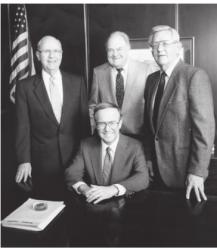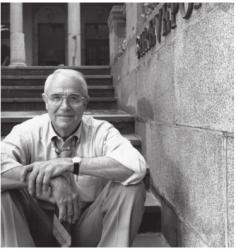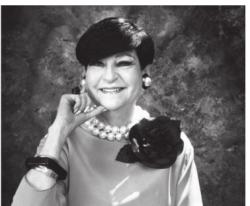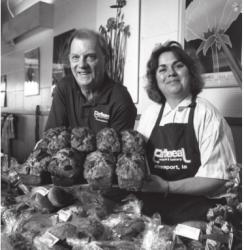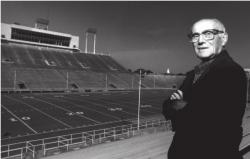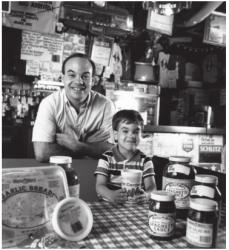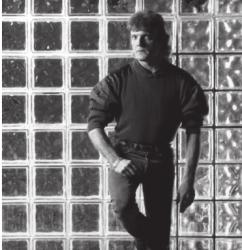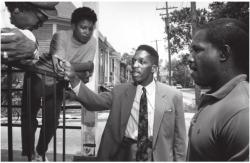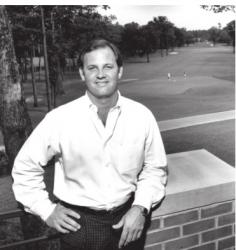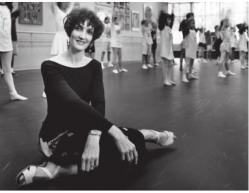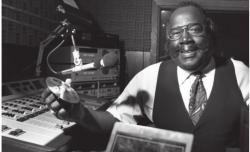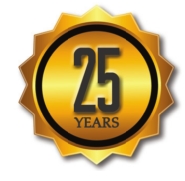
HAPPY 25TH BIRTHDAY TO THE FORUM! Throughout the next twelve months, we will celebrate the history of Shreveport- Bossier as seen through the eyes of Forum during those years –1988-2013 – from our archives and collective memories. The following account is shared in first person from the publisher. Watch for our timelines, year by year, over the next 24 issues. We will also repeat some features and articles that have relevance today. We hope you enjoy a stroll with us down memory lane as we reminisce. ENJOY.
On the cover: Photo by John Haehn Photography • Suit and tie from John Pickens Clothier • Styling and makeup by Ebony Parson
Only one word can describe the journey that has been The Forum – wow! Twenty-five-years and never a dull moment. A perfect fit for a personality type such as mine: I need a beginning and an end, and it happens with every edition. With this one, we will have published almost 1,000 issues. As we have developed, grown and fine-tuned our publication, we have always tried to lead and be a cheerleader for our area. We know and appreciate both good times and bad. After all, we launched our publication during the toughest of times.
It was 1988 and we were at the depths of the oil bust. My friend and business partner, the late Dennis Harckom, and I planned the publication from my back patio and a prime seat at The Village Grille. We were neighbors and had worked together at UpState Newsweekly (I was the last original employee before the publication folded around the end of 1986 or so). The advertising community execs, designers and festival chairs all hung out there at the new hotspot The Village Grille and there was an energy that was shared. Some of the faces frequently there: Anne Gremillion, Kip Holloway, Michael and Judy Williams, the late Mike Dean and then-wife Judy, Guy Benjamin, Bill Joyce and many others. So over martinis and patio talks, The Forum started to come together as a plan.
A serendipitous thing happened exactly one year after the other the rental fee of the storage space: $600. It felt like we hit the lottery when two archaic but still useful typesetters along with office furnishings, dark room camera, and more were revealed behind that rollup door.
It was time to get real and move forward. I had one major concern and publication folded. I had called the bank shortly after the business closed and asked what they were doing with UpState’s remaining
assets. I was setting up my own advertising agency and needed some
furniture and such. My long forgotten call was finally returned exactly
one year later and the bank told us that we could buy the contents of
the storage unit that held whatever was left. We could get it for two requirements in order for me to participate. The concern? Harckom
was a very good friend. Working with friends or family is often a recipe
for disaster. I didn’t want to potentially lose a best friend, but we
acknowledged it could happen (and eventually it did). My other two
requirements were that the name had to be Forum and that I would
have 51 percent ownership. It was a battle royal but that is how it all
shook out. That’s when the real work started.
It was 1988 and we were at the depths of the oil bust. My friend and business partner, the late Dennis Harckom, and I planned the publication from my back patio and a prime seat at The Village Grille.”
•••
In the Beginning
We were originally housed in three office spaces in a building on Jordan Street that we rented from Pete Camp. After two years the building sold and we later relocated to the more than 100-yearold building on Texas Avenue that we now occupy. It’s interesting to know that this was the former office of Shreveport Landmark, a Charles Beaird business. Dr. Beaird was the last publisher of the evening paper, the Shreveport Journal. In its past the building had been a dry goods store, a boarding house, a gambling hall and, supposedly, a brothel. We’ve had employees through the years who thought the building was haunted but I haven’t seen any ghosts. We plan to show the building as it was 100 years ago and review that history with you in a later edition.
The day before we were to visit the proposed new space a fire occurred on the second floor. The skylight and ceilings collapsed and the walls were burned and scorched. But we had to move. Our 30 final days in the previous location
was up and we had nowhere else to go. I managed to get a phone line and
a desk in one of the least damaged offices so we could continue to
operate. Though the fire marshal kept throwing us out, we kept slipping
back in until the reconstruction was complete.
 We
rented two offices and I asked that it include the hall space, which
was wide and office size, but not enclosed. So our sales department and
our graphics department – two people – were stationed in the hallway. We
made it work. As we grew through the years we took on more space, and
eventually bought the building and now occupy the entire structure. We
love our piece of old Shreveport at 1158 Texas Ave. (The big red and
white rooster is on the corner next to our building. He gets a lot of
attention.)
We
rented two offices and I asked that it include the hall space, which
was wide and office size, but not enclosed. So our sales department and
our graphics department – two people – were stationed in the hallway. We
made it work. As we grew through the years we took on more space, and
eventually bought the building and now occupy the entire structure. We
love our piece of old Shreveport at 1158 Texas Ave. (The big red and
white rooster is on the corner next to our building. He gets a lot of
attention.)
My
partnership with Harckom was over in early 1990 when I purchased his
shares. Things were awkward between us and we did not lay eyes on each
other for an entire year, though we traveled the same streets and lived
in the same neighborhood. I missed my friend – and still do. By some
fate of chance, I did get to see him and visit with him on a Saturday
the last weekend in September in 1991. I was very happy and optimistic
we would be friends again. It felt good.
Just two days later calls came to our office looking for Harckom’s family. Schumpert emergency room reps knew Harckom from Forum. I
hurried to the emergency room, not knowing what to expect. The
officials told me that he had been in an accident. The family, including
Harckom’s bride of just one year, were soon there. In an early sunrise
photo shoot on that chilly day, carbon monoxide from the vehicle had
leaked in through the rear glass of his van, which was slightly ajar.
His client, a local realtor found him. Not long after we all gathered in
the family room in the ER, Dennis, my friend, was pronounced dead. I
will never forget the look on his wife’s face when we were told. This
happened to be on the birthday of our senior sales person, Virginia St.
John, so I remember both occasions on that day every year. It was a very
sad time. Many in the advertising community knew and liked Harckom. He
is still missed.
Forum carried
on. It’s what we do and would not be the last time we would work
through tragedy or tough times. We put on our best face and marched
forward.
•••
Pure Sweat Equity
When we started, we created a mock-up of what Forum would
look like and used pure bravado to sell what we were offering in the
weak economic environment. At the time we must have been convincing. No
one had business. Crime was rampant. Line Avenue businesses were
constant victims of smash-and-grab robberies. Bars went up on the
windows of the businesses. Crack was everywhere, as was related crime.
Your plumbing pipes could be stolen from under your house while you
slept, air conditioners too.
This
was also the time of the Cedar Grove riot. A drug deal gone bad erupted
into violence and flames. Two businesses were burned as Molotov
cocktails were hurled at the burning building. The be 45 minutes. It
pretty much killed the nightlife in Shreveport, particularly Shreve
Square, neither of which to this day not recovered.
Were
we crazy to be starting a business? Probably. But what else was there
to do? Neither of the owners was paid a salary in the first two years:
pure sweat equity. Boy, did we sweat it.
While our company has now produced tens of millions of dollars in advertising, police chief decided to pull back and let the fire – and the anger –
burn itself out. It was national news and the city had a long recovery
from this and other similar incidents. Drive-by shootings and
carjackings were common place. No one felt truly safe.
The only job at ‘The Forum’ I’ve never done is to actually deliver a paper route. I would do so today if I were needed to.”
DWI
roadblocks were the new normal under new Police Chief Charles Gruber.
It seemed like a police state (again national news) and we all knew
someone (maybe even ourselves or a family member) who had been busted.
There were probably only about three taxi cabs in the city and the wait
could our first year sales were around $60,000. That had to pay
printing, utilities, rent and our two employees as well as permits and
insurances. Somehow we did it. Somehow we managed.
•••
Before the Digital Age
Between 1990 and 1992 things were starting to really take off for the company and I started getting paid!
To
talk about the early days would be like some of us used to hear the
tales of our grandparents: “We walked five miles to school in the snow
with cardboard in our shoes.” Well, it really was about that
tough. The typesetters were massive computers, the size of small cars,
that they had a one-line display, no memory and photo paper was
processed in a chemical bath. You had to allow printed materials to dry,
then you waxed, pasted and corrected. It was torturous. We would often
leave work with border tape and pieces of type stuck to us from head to
toe.
 In
the first two years, not only did we do all the selling, and paste-up,
at the end of our production cycle (on a Sunday night, usually about two
or three in the morning), Dennis and I would put the mechanical
versions of the pages in a large box, load up in a Ryder truck we had
picked up the day before, and drive it to the printer in Alexandria on
the ‘old’ Highway 71. It seemed a million miles. There we spent the
entire day supervising the printing, sometimes sleeping in the back of
the truck, while the presses rolled. We then drove our heavy load of
magazines back to Shreveport and unloaded the bundles by hand. Good
thing we were young and strong! The only job at The Forum I’ve never done is to actually deliver a paper route. I would do so today if I were needed to.
In
the first two years, not only did we do all the selling, and paste-up,
at the end of our production cycle (on a Sunday night, usually about two
or three in the morning), Dennis and I would put the mechanical
versions of the pages in a large box, load up in a Ryder truck we had
picked up the day before, and drive it to the printer in Alexandria on
the ‘old’ Highway 71. It seemed a million miles. There we spent the
entire day supervising the printing, sometimes sleeping in the back of
the truck, while the presses rolled. We then drove our heavy load of
magazines back to Shreveport and unloaded the bundles by hand. Good
thing we were young and strong! The only job at The Forum I’ve never done is to actually deliver a paper route. I would do so today if I were needed to.
Fax
machines had just become available if you could afford them, there were
no major storage devices for huge graphics files and photos such as we
use now. The paper was in mechanical form and the pasteups, along with
the photos, had to be driven or bused to the printer. Every ad proof had
to be hand delivered, no matter how many times the customer changed the
ads. Cell phones were an expensive rarity and very few people had them.
We definitely did it the hard way.
•••
Keeping the momentum
Fast
forward a few years: The paper had grown and grown. We had a fabulous
printer that gave us dazzling issues and the best paper and print we
could buy. The issues became massive at more than 100 pages (we were now
publishing every two weeks). Readers thought the issues were big and
took a while to get through. It was 2005 and it was time to take the
step and go weekly. We were very excited and had many promising large
corporate advertisers signing on for a weekly format. We were rolling
full steam ahead and had made the announcement. Then the sky fell.
•••
Through stormy weather
Hurricanes
Katrina and Rita devastated the Gulf coast. The American psyche was
damaged, to me, in an irreparable way. Washington wasn’t there for us.
News stories showed us what looked like a disaster in a third world
country. How could this
happen? The brutality was unbelievable. I didn’t know then, and still
don’t understand now, how we can’t get water and food to anywhere in the
United States within a few hours when such disasters happen. The lesson
was we better look out for ourselves and each other: Our government
couldn’t or wouldn’t help.
That
was August 29, 2005. We could have called off moving forward with our
weekly plans, but we determined we must move forward. Unfortunately, it
was hard to convince the rest of America – and the big corporate
advertisers that we had counted on – that this part of the state was not
underwater. That held true for a couple of years. The company was fine
and we were making the same money, we just worked much, much harder to
do it.
One
of our greatest difficulties was the loss of our printer in Harahan.
They were literally washed away. They were the most extraordinary
printer we had found and their quality was part of our success. We spent
two years – to our detriment – to try to keep the printing in
Louisiana. We felt it was most important to support our state in tough
times. Unfortunately the quality wasn’t there. Every week we waited for
the issue to return. We were not waiting with the excitement we had all
felt before as each publication returned from press, illustrating our
hard work. Instead, we were waiting to see the printing and what might
be wrong. It was brutal, and, finally, we made the agonizing decision to
move our printing to Texas where we remain today.
In
early 2007 while analyzing budgets, it became clear that expenses
continued to climb, while sales remained the same. Our group worked
really hard, but it is very difficult to overcome dramatic headlines
about the national economy and the disasters we faced along with a war
that had gone on for years. We began to cut expenses. While the
Haynesville Shale was now coming into play, saving our region from the
financial devastation that was happening around the country, we all
still felt the pain and it played into all of our planning and decision
making. I think that is still the case today across the country as we
are constantly in a “wait and see” mode before making decisions. So many
businesses, though much improved, were and are still on hold.
In
October of 2010 we returned to our biweekly format and the large
editions that our readers love. And we could breathe after those five
years of intensive work and pressure. Those hard years faded in memory
somewhat as we forged ahead.
We
embrace change as it occurs. We adapt with the times, as all businesses
should. We serve our existing readers and clients and reach out to
newcomers, the upwardly mobile as well as young people as they mature
and engage with us.
Our focus has always been on the positive and we are a recorded
history of the people, culture and businesses of the city who can and do
make a difference.”
•••
What’s to come
Thank you for sharing F o r u m ’
s personal journey in this issue. We look forward to keeping our
product fresh and interesting. Our job is simply to inform, entertain
and engage. As I said earlier, The Forum is, has been and will
always be Shreveport-Bossier City’s biggest cheerleader. Our focus has
always been on the positive and we are a recorded history of the people,
culture and businesses of the city who can and do make a difference.
Throughout this year, we have several surprises in store, so stay tuned. The Forum is
here to serve and we will continue to do it with our own brand of style
and vision. What we do, we do for you. Thanks for continuing to pick us
up or read us online!
– Jay Covington, Publisher

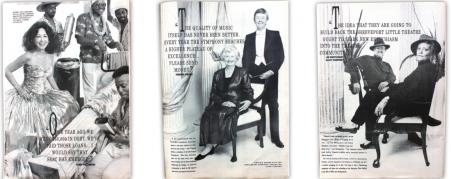
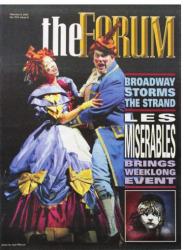
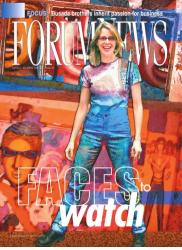
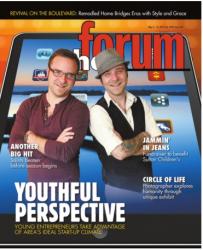
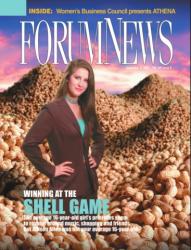
The cover and images below are from our second issue in 1988. “For the Love of Art” was a “photographic appeal for community support.” These incredible images were taken by founding partner Dennis Harckom. Pictured are (left to right): Arts advocate Penne Mobley and legendary artist Clyde Connell (look for a visit with Connell in an upcoming issue); Shreveport Regional Arts Council’s Chairman Sandi Kallenberg and music group Kumba; Community icon Virginia Shehee with popular Shreveport Symphony conductor Peter Leonard; Theater and acting enthusiasts, as well as great friends, the much beloved Jim Montgomery and Nancy Humphrey.
From the early years:
clockwise from top left: A coup for us: Four mayors in one photo. Former
mayors Jim Gardener, Calhoun Allen, Billy Hanna and John Hussey.
Orvis Sigler oversees the Poulan Weedeater Independence Bowl. Photo by Scot R. Smith.
Dominic Cordaro and son at the original Mama Mia’s location. Photo by Scot R. Smith.
Bobby Darrow stands on the frontline in the fight against AIDS. Photo by Scot R. Smith.
Silver Dollar Grocery’s T. J. Mandina and daughter Malissa (Missy). Photo by Scot R. Smith.
Southern Trace developer Johnson Ramsey. Photo by Dennis Harckom.
Noted heart surgeon Dr. Mary Catherine Mancini. Photo by Scot R. Smith.
Donald Aytch rules the night with jazz. Photo by Scot R. Smith.
Carol Anglin of Carol Anglin’s Dancenter keeps us on our toes. Photo by Scot R. Smith.
The ever popular John and Katie Koellen of Earthereal Restaurant and Bakery. Photo by Scot R. Smith.
Woman of style Betty Segall. Photo by Scot R. Smith.
Civic-minded Al Kessler pushes up his shirtsleeves for business. Photo by Scot R. Smith
Below: Caddo Parish Commissioner Michael Williams was profiled as a caring community leader. Photo by Scot R. Smith
